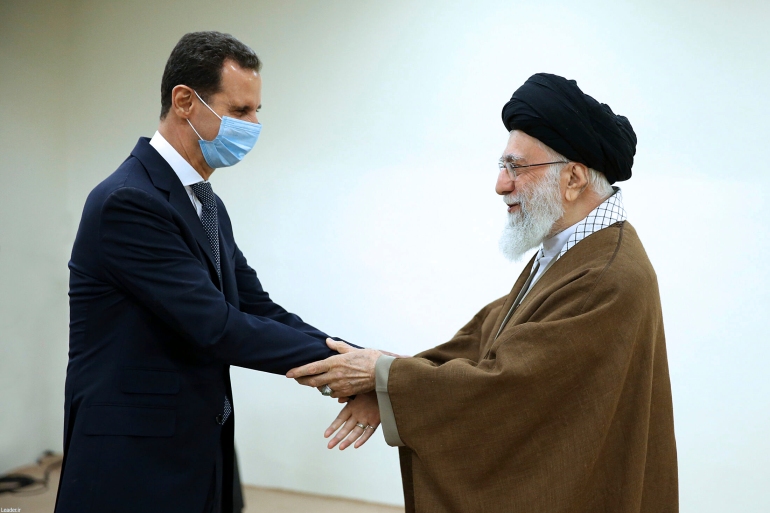[a
Syrian President Bashar Assad’s four-hour visit to Tehran last week, when he met with senior Iranian officials, gained extensive political and media attention, with both sides exchanging praise.
Regardless of the length of Assad’s visit and the secrecy and lack of official protocol involved, it had several significations and political messages from both the Syrian leader and his hosts in Tehran. The comments made by Iranian Supreme Leader Ali Khamenei, other senior Iranian officials and the Foreign Ministry came as no surprise to Arab countries. Their significance lies not in their content but in their timing amid fast-moving regional and international developments. Another layer of significance lies in their implications and the messages they transmitted in light of Russo-Iranian interactions against the backdrop of Moscow’s escalation of its war on Ukraine.
Another significant factor lies in the high level of the meeting between Assad and President Ebrahim Raisi, as well as with Khamenei. Assad’s meetings with Iran’s senior leadership are usually reserved for discussing major regional and international developments. From Iran’s perspective, Assad’s visit served to restore momentum in the relations between the two countries and raise the level of interactions.
It could be argued that Assad’s visit to Tehran had an economic purpose. His government is suffering from multiple economic crises, along with a worsening energy crunch. Assad is aware that there will be no Western aid or international facilitations, with the West insistent on aid being linked to reconstruction following Syria’s political transition. Another factor behind Assad’s visit was the decline in Russian oil and hard currency support, as Moscow is preoccupied in Ukraine.
While the visit was important for Assad, for Tehran it also provided an opportunity to exploit all its regional levers and coordinate its positions to address the regional and international developments and modify its policies to make further gains and reduce the obstacles facing it, whether related to the nuclear talks or softening the repercussions of the Ukrainian crisis on the Syrian file. Tehran wants to strengthen its alliances and cement its strategic relations with Damascus. This comes as Russia is busy fighting a war of attrition in Ukraine. This has given Tehran an opportunity to pause for breath in the Syrian arena. It is possible that Assad’s visit to Tehran was either the result of a compromise between the two sides or was viewed as a means to fill the void left by Russia to prevent any new actors from entering the Syrian arena and stopping the current actors from bolstering their power there.
It might also be that the visit was intended to serve Russia’s involvement in Ukraine by imposing a new arrangement regarding control of the spheres of influence between Tehran and Moscow. Perhaps Iran took this step out of concern that, in light of the soaring tensions between Russia on the one hand and Europe and the US on the other, Syria might be used by the concerned parties against each other. More precisely, Tehran is attempting to redraw the map of its strategic interests in Syria through a face-to-face meeting between the two countries’ leaders in Tehran. This is in anticipation that Russia — as part of its efforts to address the Ukrainian crisis — may use Iran’s interests in Syria as a bargaining chip with the world powers.
While all this is going on, Arab countries are making their own moves and adopting new policies and understandings, as seen in the recent talks between Saudi Arabia and Iran and the steps taken by some Arab countries to reconnect Syria with its Arab sphere through economic cooperation agreements in fields such as energy and electricity. These moves form part of an attempt to help Syria reduce its dependence on Iran, enabling it to disentangle itself at least partially from Tehran.
These moves, in turn, motivate Iran to divert any possible Syrian realignment to ensure it does not contradict its own interests. Iran, via Assad’s visit, may have intended to send discreet messages to the relevant regional parties concerned with countering its influence that it will not allow any changes that might adversely influence or reduce the power of the so-called resistance axis that it is nominally leading and which extends from Iraq through Syria to Lebanon and Yemen. Iran also wants to clearly assert that it does not intend to surrender or relinquish overlapping spheres of influence in Syria.
Tehran wants to strengthen its alliances and cement its strategic relations with Damascus.
Dr. Mohammed Al-Sulami
Tehran intends to send these hostile messages despite the cautious diplomatic trajectory launched between itself and several Arab capitals with the aim of reaching partial settlements on some disputed issues.
The talks between Assad and Iranian officials did not omit the issue of reconstructing Syria. Assad seeks to end his regime’s isolation and find a political resolution compatible with his preferences. Thus, Assad’s two major diplomatic visits so far this year — the first to the UAE and the second to Iran — were both made in the context of creating more room for maneuver. In reality, Tehran does not oppose Assad visiting Arab capitals.
Tehran is insistent on resisting any effort to sideline its strategic interests in Syria. The comments made by Assad, Raisi and Foreign Minister Hossein-Amir Abdollahian all echoed this position. This was also reiterated by Khamenei.
It is apparent, therefore, that Assad’s visit to Tehran could be read in the context of Iran’s desire to further entrench itself as a primary regional power, provided its ambitions are put into action in Syria. In fact, this objective is ever more apparent from the multiple visits to Syria by Iranian officials over the past two years — starting with the visit of Parliament Speaker Mohammed Bagher Ghalibaf, followed by Industry and Trade Minister Reza Fatemi-Amin and Roads and Urban Development Minister Rostam Qasemi. These were in addition to the now-routine visits to Damascus by Iran’s foreign minister and other diverse Iranian delegations.
Another striking factor about the visit was the language used by both sides, with their focus on expelling “foreign armed forces” and supporting the “resistance axis.” The foreign forces in Syria criticized by Assad and Iran’s regime obviously do not include the Iranian forces and proxy militias — since, from the perspectives of Assad and Iran, these are now indistinguishable from Syria’s regular forces.
Iranian and Syrian officials both took aim at the presence of Turkish and US troops in Syria, indicating the heightened tensions between Tehran and Ankara in both Iraq and Syria. Turkey is determined to tip the regional balance of power in its favor, whether through launching military operations against PKK forces in the Turkey-Iraq-Syria triangle and activating its cooperation with the Kurdish government in Erbil or extending gas pipelines to Iraq. Tehran considers the latter move to be a threat to its own standing in energy markets.
Iran is also concerned about the accelerating Turkish moves to complete its separation wall project on the Syrian-Iraqi border. Iran is concerned about this project as it will deprive its proxies of their ability to easily penetrate Turkey through unchecked border crossings.
The primary focus of Tehran during Assad’s visit was on ratcheting up its customary fiery rhetoric and superficial threats to Israel, promoting itself as the sole defender of the Palestinian cause and bringing about a rapprochement between Hamas and Hezbollah, with the latter focusing on opening a new chapter in its confrontation with Tel Aviv. In reality, this new chapter is a symbolic escalation and an attempt to boost Tehran’s coordinated grassroots-oriented propaganda. It is primarily linked to Iranian political objectives at the Vienna nuclear deal talks and in no way can be considered a victory for the Palestinian cause. In reality, neither Iran nor Hezbollah dare to attack Israel, with both avoiding any direct military response to Israeli attacks, which have continued for years. Moreover, the actual attacks mounted by Iran’s proxies have been launched from sites in Arab territories, whether in Syria or Iraq.
It is also noteworthy that nobody is able to definitively specify what Tehran can practically offer Syria as it aims to reconstruct and salvage its economy. No matter how hard one tries, it is impossible to get blood out of a stone or secure funding for reconstruction from a bankrupt state. For all the rhetoric, the economic conditions in Syria and Iran are strikingly similar, with both suffering from catastrophic economic decline due to economic sanctions and vast military expenditure. The people’s pockets and stomachs in both countries are empty. Given the low level of trade and commercial business between the two countries, the realization of Iran’s Syrian reconstruction vision is impractical and an unaffordable pipe dream.
Based on all the aforementioned, Assad’s visit to Tehran was, in reality, significant only in the context of the repeated Iranian messaging. It was intended to reiterate that Tehran will continue to move ahead with its regional colonial project and expansion in Syria — a message that is gaining strength and becoming more apparent in light of current regional and international developments. This messaging signals genuine difficulties in disentangling the Iranian and Syrian regimes in the foreseeable future. It is possible that Tehran may hint at potential escalation in one of the regional flashpoints in which it is involved in the coming phase, especially in Syria.
Iran will continue to take advantage of any change or potential change in the rapidly shifting global order, particularly taking advantage of the Russian-Ukrainian war on the one hand and the interactions of the regional and international powers regarding the revival of the Iranian nuclear deal on the other.
• Dr. Mohammed Al-Sulami is president of the International Institute for Iranian Studies (Rasanah).
Twitter: @mohalsulami
Disclaimer: Views expressed by writers in this section are their own and do not necessarily reflect Arab News’ point of view
Source: Arab News
***Show us some LOVE by sharing it!***



